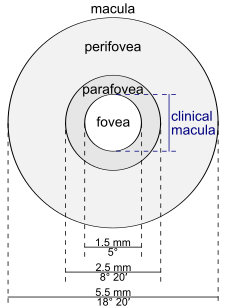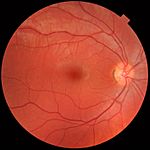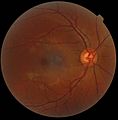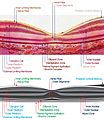Macula facts for kids
Quick facts for kids Macula |
|
|---|---|
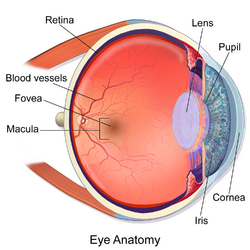 |
|
| The macula is the central part of the retina of the human eye, its center slightly shifted to the temporal side. (The location in the image is misleading: it looks as if the macula were far removed from the center which is not the case.) . | |
| Latin | macula lutea |
The macula (say: MAK-yoo-luh), also known as the macula lutea, is a small, oval-shaped spot in the middle of the retina at the back of your human eye. It's super important for seeing things clearly and in full color, especially when there's good light. Think of it as the "sweet spot" for your sharpest vision!
In humans, the macula is about 5.5 millimeters (mm) wide. It's made up of several smaller areas like the umbo, foveola, fovea, and others. If your macula gets damaged, like in a condition called macular degeneration, your central vision can become blurry or disappear.
The name "macula lutea" comes from Latin. Macula means "spot," and lutea means "yellow."
Contents
What is the Macula?
The macula is a small, oval-shaped area right in the center of the retina. The retina is the light-sensitive layer at the back of your eye. The macula is slightly off-center from the very middle of your eye's optical axis.
Even though the macula is about 5.5 mm wide, the part doctors usually look at, called the "clinical macula," is smaller, about 1.5 mm. This smaller part is actually the fovea, which is a key part of the macula.
Inside the macula, there's a tiny pit called the fovea. This pit is packed with special nerve cells called cone cells. These cones are amazing because they help you see fine details and all the different colors around you. Your retina also has rod cells, which help you see in dim light, but they don't see color.
Why is the Macula Yellow?
The macula has a yellowish color because it contains natural pigments called lutein and zeaxanthin. These are yellow carotenoids that you get from your diet.
This yellow color is very useful! It acts like a natural pair of sunglasses for your eye. It absorbs extra blue and ultraviolet light that enters your eye. This helps protect the sensitive cells in your retina from potential damage, similar to how sunglasses protect your eyes from bright sunlight. Some studies suggest these pigments might also help protect against certain eye diseases.
How the Macula Helps You See
The macula is specially designed for super clear vision. It contains a very high number of cone cells. These cones are photoreceptors, which means they are light-sensing cells.
Your eye has three types of cones, each sensitive to different colors (red, green, and blue). Your brain combines the signals from these cones to let you see millions of different colors. While rod cells help you see in dim light, they don't help with color vision.
Because the macula has so many cones, it's responsible for your central vision. This is the vision you use for reading, recognizing faces, and seeing small details. It's also why you can see things in vibrant color when there's enough light. If the macula gets damaged, this sharp, colorful central vision can be affected.
Macula and Your Eye Health
Doctors can see the macula when they look into your eye using special tools like an ophthalmoscopy or retinal photography.
If the macula is damaged, you might notice a problem with your central vision right away. This is different from losing your side (peripheral) vision, which you might not notice for a while.
One common eye condition is macular degeneration. This is when the macula slowly breaks down over time. It can lead to blurry central vision or even a blind spot. Sometimes, a severe injury to the eye can also damage the macula, leading to a "macular hole."
The macula is so important that a large part of your brain's visual system is dedicated to processing information from it. This means that even if other parts of your vision are affected by a brain injury, your central vision from the macula might still be okay. This is called "macular sparing."
Images for kids
See also
 In Spanish: Mácula lútea para niños
In Spanish: Mácula lútea para niños
- Macular degeneration
- Macular edema
- Macular pucker
- Cherry-red spot
- Macular hypoplasia
- Photic retinopathy
- Intermediate uveitis



